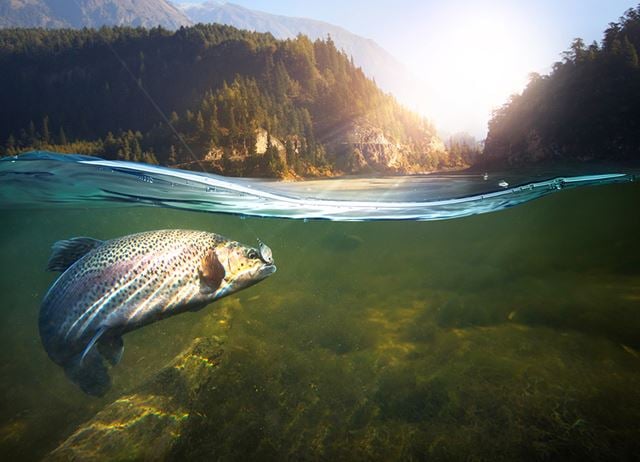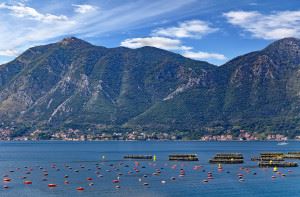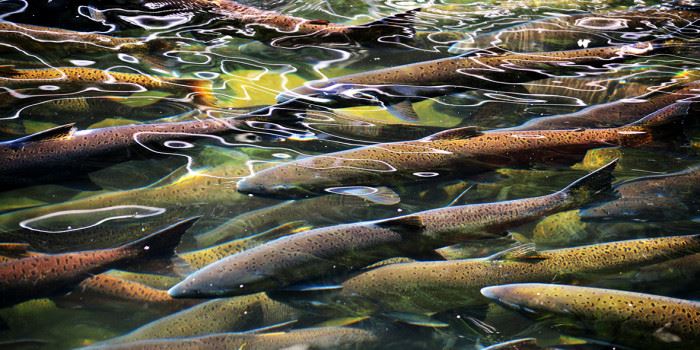SALMON: Since the start of Norway’s aquaculture adventure, the salmon industry has been challenged by disease and sea lice. In the 1990s, Norway’s third largest industry had major problems with bacteria, which required using a lot of antibiotics. Eventually effective vaccines were developed, and today salmon farming is one of the food industries that employ the fewest antibiotics.
Ways to cut disease outbreaks
- Large parts of the Norwegian coast should be divided into distinct zones. Some will be fish farming zones, and others will be zones without fish farms ("free zones").
- Stocking smolts must be based on how the water flows to avoid infection being carried from one facility to another.
- Sick fish must be removed if they pose a danger of infection for other facilities.
Now other diseases are challenging the industry. Pancreas disease (PD) is one of the most serious salmon diseases in the fish farming industry today. The virus attacks the pancreas and causes reduced growth, poor product quality and increased mortality.
PD cannot be treated with drugs, and although an approved vaccine exists against the disease, vaccination has only limited effectiveness.
Prolonged stress weakens immune system

The PD virus occurs naturally in the sea and in fish, without the fish necessarily getting sick. But when environmental factors—such as a rise in temperature, pollution and fish management—create stress over time, the immune system is weakened and disease can break out.
“The marine environment is very complex, and a lot of stressors can affect the fish. It seems that farmed salmon, like other organisms, can withstand short-term stress, but long-term stress has a negative impact,” says marine biologist and associate professor Anne Stene. She heads a research group at NTNU in Ålesund that is studying fish welfare, disease and the spread of viruses and sea lice in fish farming.
New method
“It’s difficult for us to interpret how the fish are actually doing. A lot of research is going on to find operational welfare indicators for farmed fish, and now we’ve developed tools to test and calculate stressors,” says Stene.
The researchers have developed a method that measures stress levels in salmon in a reliable and simple manner. The stress hormone cortisol can be identified in the blood of most vertebrates that are experiencing stress. The problem is that because cortisol is released into the bloodstream so rapidly, the stress resulting from taking a measurement impacts the cortisol level. This method therefore does not give a clear picture of the resting levels of cortisol.
Cortisol is also secreted in fish faeces, and the stress from sampling them affects cortisol levels only minimally. Experiments have shown that this method of cortisol measurement provides a consistent and reproducible measure of environmental stress in fish. Understanding what stresses salmon can help improve aquaculture operations and management.
- You might also like: Better fish welfare means better quality
The fjord as laboratory

PHoto: Thinkstock
Click to open
The research group is working to identify and understand how the fish become infected and how infected fish get sick. They are also looking for the pathways that spread viruses and parasites, and are exchanging resistant lice between farmed and wild salmon.
“The goal is to outline operational and management strategies to reduce and combat disease,” Stene says.
One of the strengths in the Ålesund environment is its interdisciplinary approach, with research directly in the field and in close contact with industry players. NTNU in Ålesund has a research license for salmon farming, and the bay serves as a large laboratory.
“It’s important for researchers to work closely with industry players to keep each other updated. The industry is developing rapidly, and the interaction between research and industry is valuable for industrial relevance in our studies and to arrive at optimal solutions,” says Stene.
“In laboratory experiments with statistical modelling, we may find a lot of good indications, but these also have to be tested in real field environments to see if they hold water,” she says.
Important to remove dead fish
Fighting disease is important for the welfare of the fish, for the marine environment, for profitability and for the reputation of the farming industry. And fighting disease requires an understand of how it evolves, becomes an outbreak and how pathogenic organisms are spread.
The PD virus lives in the cells of the fish. If fish get sick and die, the virus lives on in the dead fish. If the dead fish remains at the bottom of the salmon cages, some of the fish fat floats to the surface, and with it the virus. When healthy salmon come to the surface to feed, they come into contact with the fat layer and can become infected by the virus. Therefore, it is very important to remove dead fish as soon as possible.
- You might also like: Sea lice problem should translate into cutbacks in salmon farming
Infection spread by ocean currents
Wind and rain can carry the fat layer to neighbouring aquaculture facilities. Ocean currents also spread the virus. Using a hydrodynamic model developed at SINTEF Fisheries and Aquaculture (www.sinmod.no), Stene demonstrated that the spread of the virus between fish farms happens primarily via ocean currents. Fish farms located close to facilities with infected salmon have a greater risk of also becoming infected.
Human activity and other organisms can be another source of infection. The PD virus and other pathogens (disease-causing viruses and organisms) can spread via boats and via crews and equipment that are used by several facilities. Thus, hygiene is a very important tool against the spread of infection.
A look into the future of aquaculture
“Water seems to be the major pathway for the spread of pathogens between salmon farms. At NTNU in Ålesund we have a joint venture going with several players in water transport. We’re developing models to better understand the spread of infection and eventually get better at anticipating the transport of pathogens in bodies of water. Only then can we take action and organize industry to limit infections,” says Stene.

